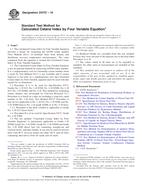Potřebujeme váš souhlas k využití jednotlivých dat, aby se vám mimo jiné mohly ukazovat informace týkající se vašich zájmů. Souhlas udělíte kliknutím na tlačítko „OK“.
ASTM D525-12a
Standard Test Method for Oxidation Stability of Gasoline (Induction Period Method) (Includes all amendments And changes 12/12/2019).
Automaticky přeložený název:
Standardní zkušební metoda pro oxidační stability Benziny (indukční období metoda)
NORMA vydána dne 1.9.2012
Informace o normě:
Označení normy: ASTM D525-12a
Poznámka: NEPLATNÁ
Datum vydání normy: 1.9.2012
Kód zboží: NS-30448
Počet stran: 8
Přibližná hmotnost: 24 g (0.05 liber)
Země: Americká technická norma
Kategorie: Technické normy ASTM
Kategorie - podobné normy:
Anotace textu normy ASTM D525-12a :
Keywords:
breakpoint, gasoline, induction period, oxidation stability, ICS Number Code 75.160.20 (Liquid fuels)
Doplňující informace
| Significance and Use | ||||||||
|
The induction period may be used as an indication of the tendency of motor gasoline to form gum in storage. It should be recognized, however, that its correlation with the formation of gum in storage may vary markedly under different storage conditions and with different gasolines. |
||||||||
| 1. Scope | ||||||||
|
1.1 This test method covers the determination of the stability of gasoline in finished form only, under accelerated oxidation conditions. (WarningThis test method is not intended for determining the stability of gasoline components, particularly those with a high percentage of low boiling unsaturated compounds, as these may cause explosive conditions within the apparatus. However, because of the unknown nature of certain samples, the pressure vessel assembly shall include a safety burst-disc in order to safeguard the operator.) Note 1—For measurement of oxidation stability of gasoline by measurement of potential gum, refer to Test Method D873, or IP Test Method 138. Note 2—The precision data were developed with gasolines derived from hydrocarbon sources only without oxygenates. 1.2 The accepted SI unit of pressure is the kilo Pascal (kPa), and of temperature is °C. 1.3 WARNINGMercury has been designated by many regulatory agencies as a hazardous material that can cause central nervous system, kidney and liver damage. Mercury, or its vapor, may be hazardous to health and corrosive to materials. Caution should be taken when handling mercury and mercury containing products. See the applicable product Material Safety Data Sheet (MSDS) for details and EPA’s websitehttp://www.epa.gov/mercury/faq.htmfor additional information. Users should be aware that selling mercury and/or mercury containing products into your state or country may be prohibited by law. 1.4 This standard does not purport to address all of the safety concerns, if any, associated with its use. It is the responsibility of the user of this standard to establish appropriate safety and health practices and determine the applicability of regulatory limitations prior to use. |
||||||||
| 2. Referenced Documents | ||||||||
|
Podobné normy:
Historická
1.10.2011
Historická
1.12.2011
Historická
1.10.2010
Historická
15.6.2013
Historická
1.11.2012
Historická
1.8.2010



 ASTM D4418-00(2011)..
ASTM D4418-00(2011).. ASTM D4529-01(2011)..
ASTM D4529-01(2011).. ASTM D4539-10
ASTM D4539-10 ASTM D4682-13
ASTM D4682-13 ASTM D473-07(2012)..
ASTM D473-07(2012).. ASTM D4737-10
ASTM D4737-10
 Cookies
Cookies
